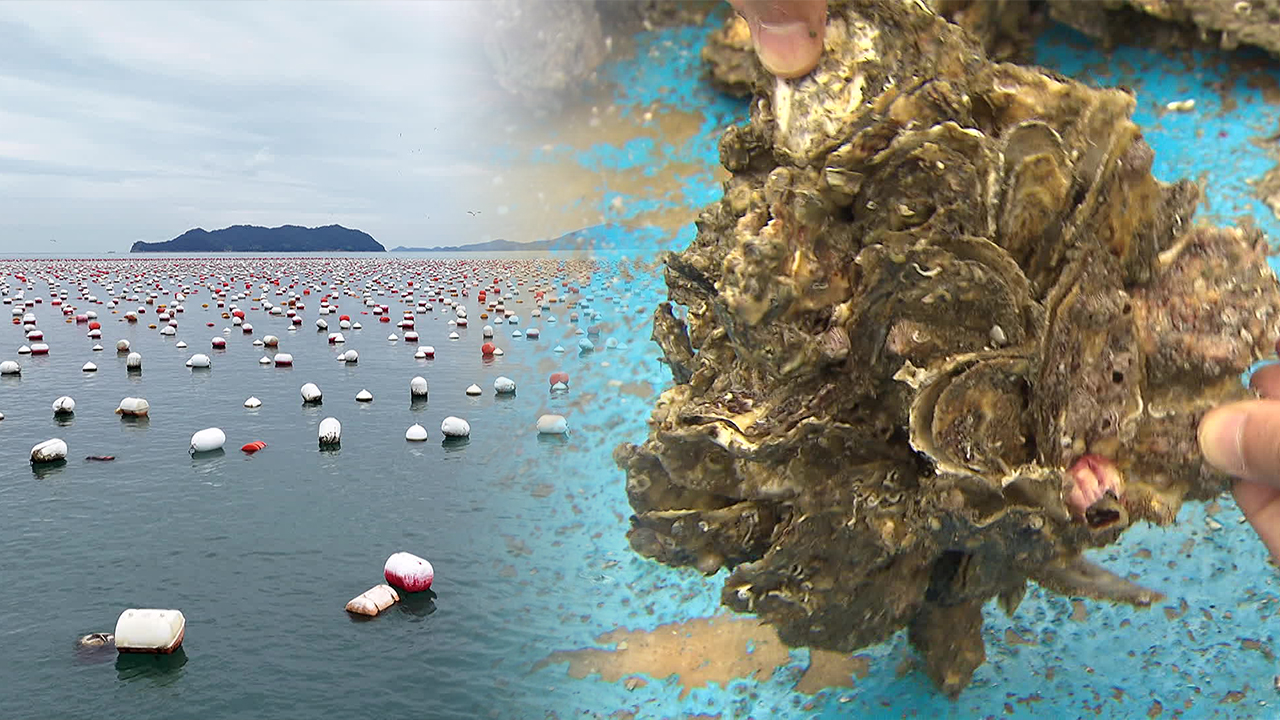Harvest season sees continuous ‘oyster deaths’, leaving fishing community ‘devastated’
입력 2024.10.08 (05:25)
읽어주기 기능은 크롬기반의
브라우저에서만 사용하실 수 있습니다.
[Anchor]
During the kimjang season, oysters are considered just as important as Korean cabbage.
As you have seen earlier, the price of Korean cabbage has risen significantly, and with mass die-offs occurring in domestic oyster farms ahead of the harvest season, there are concerns about oyster prices as well.
Lee Hyung-kwan reports.
[Report]
At an oyster farm on the southern coast of Gyeongnam Province.
As we pull up the 7-meter-long cultivation line from the sea, a foul odor fills the air.
["It smells, right? (It smells rotten.)"]
Most of the oysters pulled from the sea are just empty shells.
The few with visible meat are small and seem to have stopped growing.
Fishermen cannot hide their despair.
[Heo Tae-sam/Hail-myeon, Goseong-gun, Gyeongnam Province : "I've been farming oysters for 55 years, and I've never seen a year like this. There's no point in operating the farm, and I can't do it. I just can't."]
This summer, the southern coast has been hit hard by the worst high-temperature on record, and recently, mass die-offs of oysters have followed.
The reported damage in Tongyeong, Goseong, and Geoje in Gyeongnam Province exceeds 1,130 hectares.
This is about 35% of the total farming area, marking the largest damage ever recorded.
The unprecedented high temperatures and phenomena of oxygen-depleted water are believed to be the causes.
[Kim Woo-seok/Chairman of Oyster Farming Association in Goseong, Gyeongnam Province : "At times like this, we need to collect samples to investigate the cause, but the authorities are not responding at all."]
The bigger problem lies ahead next year.
Due to the mass die-offs or poor growth of oysters that were seeded this spring, there are concerns about a decrease in harvest volume.
A chain of damage is expected, from those involved in processing live oysters to oyster farmers.
[Ha Gap-i/Hail-myeon, Goseong-gun, Gyeongnam Province : "We rely entirely on oysters for our livelihoods, including those who shuck the oysters... Given the current situation, we feel hopeless."]
Oyster farmers are left in despair due to the mass die-offs.
They are demanding that the authorities actively investigate the causes of the die-offs and the extent of the damage.
This is KBS News, Lee Hyung-kwan reporting.
During the kimjang season, oysters are considered just as important as Korean cabbage.
As you have seen earlier, the price of Korean cabbage has risen significantly, and with mass die-offs occurring in domestic oyster farms ahead of the harvest season, there are concerns about oyster prices as well.
Lee Hyung-kwan reports.
[Report]
At an oyster farm on the southern coast of Gyeongnam Province.
As we pull up the 7-meter-long cultivation line from the sea, a foul odor fills the air.
["It smells, right? (It smells rotten.)"]
Most of the oysters pulled from the sea are just empty shells.
The few with visible meat are small and seem to have stopped growing.
Fishermen cannot hide their despair.
[Heo Tae-sam/Hail-myeon, Goseong-gun, Gyeongnam Province : "I've been farming oysters for 55 years, and I've never seen a year like this. There's no point in operating the farm, and I can't do it. I just can't."]
This summer, the southern coast has been hit hard by the worst high-temperature on record, and recently, mass die-offs of oysters have followed.
The reported damage in Tongyeong, Goseong, and Geoje in Gyeongnam Province exceeds 1,130 hectares.
This is about 35% of the total farming area, marking the largest damage ever recorded.
The unprecedented high temperatures and phenomena of oxygen-depleted water are believed to be the causes.
[Kim Woo-seok/Chairman of Oyster Farming Association in Goseong, Gyeongnam Province : "At times like this, we need to collect samples to investigate the cause, but the authorities are not responding at all."]
The bigger problem lies ahead next year.
Due to the mass die-offs or poor growth of oysters that were seeded this spring, there are concerns about a decrease in harvest volume.
A chain of damage is expected, from those involved in processing live oysters to oyster farmers.
[Ha Gap-i/Hail-myeon, Goseong-gun, Gyeongnam Province : "We rely entirely on oysters for our livelihoods, including those who shuck the oysters... Given the current situation, we feel hopeless."]
Oyster farmers are left in despair due to the mass die-offs.
They are demanding that the authorities actively investigate the causes of the die-offs and the extent of the damage.
This is KBS News, Lee Hyung-kwan reporting.
■ 제보하기
▷ 카카오톡 : 'KBS제보' 검색, 채널 추가
▷ 전화 : 02-781-1234, 4444
▷ 이메일 : kbs1234@kbs.co.kr
▷ 유튜브, 네이버, 카카오에서도 KBS뉴스를 구독해주세요!
- Harvest season sees continuous ‘oyster deaths’, leaving fishing community ‘devastated’
-
- 입력 2024-10-08 05:25:04

[Anchor]
During the kimjang season, oysters are considered just as important as Korean cabbage.
As you have seen earlier, the price of Korean cabbage has risen significantly, and with mass die-offs occurring in domestic oyster farms ahead of the harvest season, there are concerns about oyster prices as well.
Lee Hyung-kwan reports.
[Report]
At an oyster farm on the southern coast of Gyeongnam Province.
As we pull up the 7-meter-long cultivation line from the sea, a foul odor fills the air.
["It smells, right? (It smells rotten.)"]
Most of the oysters pulled from the sea are just empty shells.
The few with visible meat are small and seem to have stopped growing.
Fishermen cannot hide their despair.
[Heo Tae-sam/Hail-myeon, Goseong-gun, Gyeongnam Province : "I've been farming oysters for 55 years, and I've never seen a year like this. There's no point in operating the farm, and I can't do it. I just can't."]
This summer, the southern coast has been hit hard by the worst high-temperature on record, and recently, mass die-offs of oysters have followed.
The reported damage in Tongyeong, Goseong, and Geoje in Gyeongnam Province exceeds 1,130 hectares.
This is about 35% of the total farming area, marking the largest damage ever recorded.
The unprecedented high temperatures and phenomena of oxygen-depleted water are believed to be the causes.
[Kim Woo-seok/Chairman of Oyster Farming Association in Goseong, Gyeongnam Province : "At times like this, we need to collect samples to investigate the cause, but the authorities are not responding at all."]
The bigger problem lies ahead next year.
Due to the mass die-offs or poor growth of oysters that were seeded this spring, there are concerns about a decrease in harvest volume.
A chain of damage is expected, from those involved in processing live oysters to oyster farmers.
[Ha Gap-i/Hail-myeon, Goseong-gun, Gyeongnam Province : "We rely entirely on oysters for our livelihoods, including those who shuck the oysters... Given the current situation, we feel hopeless."]
Oyster farmers are left in despair due to the mass die-offs.
They are demanding that the authorities actively investigate the causes of the die-offs and the extent of the damage.
This is KBS News, Lee Hyung-kwan reporting.
During the kimjang season, oysters are considered just as important as Korean cabbage.
As you have seen earlier, the price of Korean cabbage has risen significantly, and with mass die-offs occurring in domestic oyster farms ahead of the harvest season, there are concerns about oyster prices as well.
Lee Hyung-kwan reports.
[Report]
At an oyster farm on the southern coast of Gyeongnam Province.
As we pull up the 7-meter-long cultivation line from the sea, a foul odor fills the air.
["It smells, right? (It smells rotten.)"]
Most of the oysters pulled from the sea are just empty shells.
The few with visible meat are small and seem to have stopped growing.
Fishermen cannot hide their despair.
[Heo Tae-sam/Hail-myeon, Goseong-gun, Gyeongnam Province : "I've been farming oysters for 55 years, and I've never seen a year like this. There's no point in operating the farm, and I can't do it. I just can't."]
This summer, the southern coast has been hit hard by the worst high-temperature on record, and recently, mass die-offs of oysters have followed.
The reported damage in Tongyeong, Goseong, and Geoje in Gyeongnam Province exceeds 1,130 hectares.
This is about 35% of the total farming area, marking the largest damage ever recorded.
The unprecedented high temperatures and phenomena of oxygen-depleted water are believed to be the causes.
[Kim Woo-seok/Chairman of Oyster Farming Association in Goseong, Gyeongnam Province : "At times like this, we need to collect samples to investigate the cause, but the authorities are not responding at all."]
The bigger problem lies ahead next year.
Due to the mass die-offs or poor growth of oysters that were seeded this spring, there are concerns about a decrease in harvest volume.
A chain of damage is expected, from those involved in processing live oysters to oyster farmers.
[Ha Gap-i/Hail-myeon, Goseong-gun, Gyeongnam Province : "We rely entirely on oysters for our livelihoods, including those who shuck the oysters... Given the current situation, we feel hopeless."]
Oyster farmers are left in despair due to the mass die-offs.
They are demanding that the authorities actively investigate the causes of the die-offs and the extent of the damage.
This is KBS News, Lee Hyung-kwan reporting.
-
-

이형관 기자 parole@kbs.co.kr
이형관 기자의 기사 모음
-
이 기사가 좋으셨다면
-
좋아요
0
-
응원해요
0
-
후속 원해요
0















이 기사에 대한 의견을 남겨주세요.